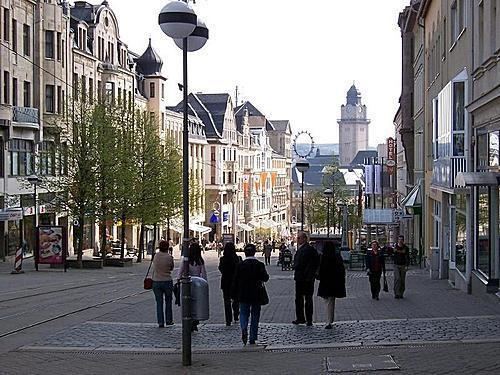Time zone CET/CEST (UTC+1/+2) Population 66,287 (31 Dec 2009) | Elevation 412 m (1,352 ft) Postal codes 08523;-5;-7;-9 Local time Tuesday 5:36 PM | |
 | ||
Weather 9°C, Wind SW at 11 km/h, 81% Humidity Points of interest Malzhaus, Vogtlandmuseum, Plauener Spitzenmuseum, Freizeitanlage Syratal, Elster Viaduct | ||
Plauen ( [ˈplaʊ̯ən]) is a town in the Free State of Saxony, east-central Germany.
Contents
- Map of Plauen Germany
- History
- Industry and infrastructure
- Main sights
- Education and science
- Notable residents
- Twin cities
- Twin cities of Jnitz urban district
- Former twin cities
- References
Map of Plauen, Germany
It is the capital town of the district Vogtlandkreis. The town is situated near the border of Bavaria and the Czech Republic.
History
Plauen was founded by Polabian Slavs in the 12th century as "Plawe" and was passed to the Kingdom of Bohemia in 1327. The town was captured by the Archbishop of Magdeburg, Lippold von Bredow, in 1384. In 1466, it was passed to Albertine Saxony and later in 1569 to the Electorate of Saxony. Plauen became incorporated into the Kingdom of Saxony in 1806 during the Napoleonic Wars.
In the late-19th century, Plauen became a centre of textile manufacturing, specializing in Chemical lace, called Plauen lace. Around 1910, Plauen, as an industrial 'boomtown' of the region, reached its population peak (1910 census: 121,000, 1912: 128,000).
In the 1930s, Plauen hosted the first chapter of the Nazi Party outside of Bavaria. Plauen's population, however, has shrunk dramatically since the Second World War (1939: 111,000 inhabitants). It was occupied by American troops on 16 April 1945 but was left to Red Army on 1 July 1945.
From 1945 onwards, Plauen fell into the Soviet occupation zone of Germany, which later became the German Democratic Republic (1949-1990). Plauen hosted a large Red Army occupation garrison and, in the last years of the GDR (DDR), an officer school of the Border Guards ("Grenztruppen der DDR"). The first mass demonstration against the socialistic regime in the GDR began in Plauen on 7 October 1989; this was the beginning of a series of mass demonstrations across the country and ultimately led to the re-unification of Germany in 1990.
The exposé Fast Food Nation gives special mention to Plauen as the first town of the GDR to have a McDonald's restaurant following the collapse of the Berlin Wall.
In the district reform of 1 July 2008, Plauen lost its urban district status and was merged into the district Vogtlandkreis.
Industry and infrastructure
Plauen (Vogtland) Oberer station lies on the Leipzig–Hof line. The section of this line through Plauen is part of the Saxon-Franconian trunk line running between Nürnberg, Hof, Plauen, Zwickau, Chemnitz and Dresden. The town had another station, Plauen (Vogtland) Unterer station (now defunct), on the Elster Valley Railway. There is a plan to rename the Oberer (Upper) station into Plauen Hauptbahnhof (Main Station).
Vogtlandbahn (Vogtland Railway), a regional train company, operates services from Plauen to Hof, Werdau, Chemnitz, Zwickau, Falkenstein and Adorf within Germany and Cheb (Eger) in the Czech Republic. At these stations, there are other Vogtlandbahn services to München, Regensburg, Marktredwitz, Dresden and Leipzig within Germany and Karlovy Vary (Karlsbad) and Prague in the Czech Republic. A Vogtlandbahn Express Bus service runs between Plauen and Berlin Schönefeld Airport and Zoological Garden.
The Plauen Straßenbahn is a tramway that has 6 lines connecting the centre of town, Plauen-Tunnel stop, to the surrounding areas and the Oberer railway station.
Main sights
Education and science
Plauen is home to a University of Applied Sciences with about 300 students and a DIPLOMA Fachhochschule.
